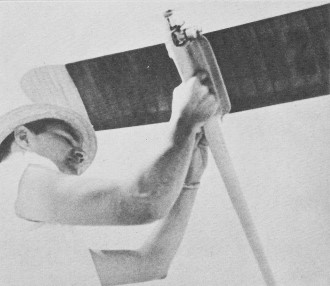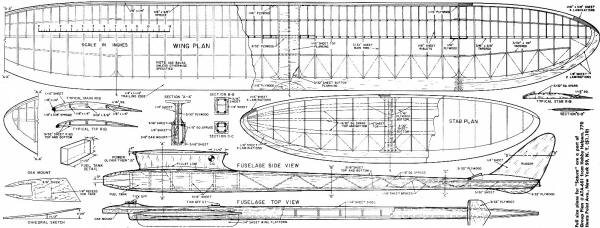|
Flying in a contest with
35 mile per hour winds is hard to imagine, but that was the case at the 1954
Nats FAI Free Flight semi-finals. Fortunately, on the day of the actual event
the winds had calmed down. I would never consider flying even an radio-controlled
model airplane in 35 mph winds, much less a free flight. Howard Timlin was
the designer,
builder, and flyer of this beautiful "Saturn," which appeared in the
November 1954 issue of Air Trails magazine. It sports a wingspan of about 60
inches with a Goldberg G-10 undercambered airfoil (same as the Carl Goldberg
Viking free flight model). Although not specified, I assume this is a Class
A model since the F1C class allows up to 0.15 cubic inches (2.5 cc). Howard had another successful contest design -
the 50" wingspan ½A "Solar" (appeared in the August
1961 American Modeler magazine).
America's Top F.A.I. Free Flight "Saturn"
 by Howard Timlin by Howard Timlin
First, I would like to thank Craig Cusick of Los Angeles, California, for
his help in the design of "Saturn." We were after a free flight which would
be able to compete with the better F.A.I. airplanes not only in turbulent Texas
but also in the ideal California weather. We wanted the maximum engine displacement
with the minimum weight requirements. We felt this combination would give a
faster climbing model which would get up better in high wind and have a good
penetrating glide due to its cleanness of design. The glide ratio was increased
for this size airplane by using a higher aspect ratio wing with a Goldberg G-10
airfoil section and a clean streamlined fuselage. This was demonstrated at the
'59 Nats where in calm weather the model won the F.A.I. event. Also, Saturn
was tested earlier at the semi-finals for the world championship team where
it flew well in a 35 mile an hour wind.
Study the plans and carefully select your wood for the various parts of the
airplane, keeping in mind that the stabilizer and wing wood should be light.

Author Timlin with Don Foote (far left) who is well known
for his "Westerner" design and air-modeling theory books. Howard's from San
Antonio.

Fuselage - Start by cutting fuselage out of 1/4" sheet balsa. Then cut your
motor mount out of 3/8" thick oak. You will have to cut about 1/8" out of the
mount so the tank will fit. Drill holes in the oak motor mount for your motor
and use blind mounting nuts. When this is done glue the motor mount to the left
side looking from front of the fuselage. Next glue the 1/8" square spruce longeron
to the fuselage sides as shown on the plans. When this is done, pin the side
with the motor mount down flat. Then cut your formers out of 3/16" sheet to
receive the pylon. Cut the 1/16" sheet webbing that runs from the pylon to the
tail section and notch for the 1/8" square spruce longerons and glue in place.
Allow to dry. Next glue the tank in place and now you can glue the right side
in place. Note the right side is shorter because the motor is side mounted.
While the fuselage is drying, cut you pylon out of 3/32" plywood and laminate
the 1/4" sheet balsa on each side, sand to a streamline shape and mount to the
fuselage.
When the pylon is dry you can sheet the top and bottom with soft 3/16" and
install the sub-rudder. Before adding the stab platform, carve the body to shape
as shown on the plan trying to keep the tail section as light as possible. When
this is completed, glue your stab platform in place and at the same time glue
the wing platform in place, sand and give the body two coats of dope and cover
with silk. I finished the body with primer and colored lacquer.
Wing - Carefully select your wood using harder stock for the center panel,
spars leading edge and trailing edge than for the tip panels. Fairly soft stock
should be used for the latter. This will give strength where it is needed most.
Be sure to block up trailing edge with 1/32" scrap balsa where the ribs are
notched into it. All ribs are cut from 3/32" sheet. The tip trailing edge is
laminated of 1/8" sheet as shown; the leading edge is four laminations of 1/16"
sheet. Keep the tips as light as possible. On all the spars sand all the corners
round so you can slip them through the ribs easily.
Stabilizer - Laminate the trailing edge out of light, 1/8" sheet and allow
to dry, then taper and notch as on plans. Laminate leading edge like tips on
the wing.
The 1/4" sheet rudder is sanded to a streamline shape and should be covered
with silk and finished before mounting.
Covering - Before covering, the model should receive two coats of dope then
be carefully sanded to a smooth finished surface. Then cover the model with
silk and give it about seven coats of 50/50 dope.
Trim - Make sure your model is balanced properly as shown on plans. Start
by hand gliding over high grass until your model is gliding right on the verge
of a stall. Saturn may require about 1/16" under the trailing edge of the stab
and 1/16" tilt for right glide. The model should climb out about 45° and
slightly to the right, making about two turns in 15 seconds.
The original was very stable in the power pattern and could be flown to the
right or left. Key your stabilizer so you have about 1/16" left rudder before
you try any power flights.
Flying - Begin flying with about one-half power with seven second motor runs.
Increase the power as the model becomes trimmed. It will take about three flights
to get power pattern and glide turn and with a few more flights and slight changes
in trim you will be able to achieve perfection in performance.

Saturn FAI Free Flight Plans
Notice:
The AMA Plans Service offers a
full-size version of many of the plans show here at a very reasonable cost. They
will scale the plans any size for you. It is always best to buy printed plans because
my scanner versions often have distortions that can cause parts to fit poorly. Purchasing
plans also help to support the operation of the
Academy of Model Aeronautics - the #1
advocate for model aviation throughout the world. If the AMA no longer has this
plan on file, I will be glad to send you my higher resolution version.
Try my Scale Calculator for
Model Airplane Plans.
Posted March 20, 2021
|